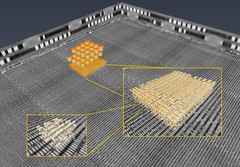Search
A new spin in nano-electronics
In recent years, electronic data processing has been evolving in one direction only: The industry has downsized its components to the nanometer range. But this process is now reaching its physical limits. Researchers at the Helmholtz-Zentrum Dresden-Rossendorf (HZDR) and the Paul Scherrer Institut (PSI) are therefore exploring spin waves or so-called magnons – a promising alternative for transporting information in more compact microchips. Cooperating with international partners, they have successfully generated and controlled extremely short-wavelength spin waves. The physicists achieved this feat by harnessing a natural magnetic phenomenon, as they explain in the journal Nature Nanotechnology.
3D imaging for planar samples with zooming
Researchers of the Paul Scherrer Institut have previously generated 3-D images of a commercially available computer chip. This was achieved using a high-resolution tomography method. Now they extended their imaging approach to a so-called laminography geometry to remove the requirement of preparing isolated samples, also enabling imaging at various magnification. For ptychographic X-ray laminography (PyXL) a new instrument was developed and built, and new data reconstruction algorithms were implemented to align the projections and reconstruct a 3D dataset. The new capabilities were demonstrated by imaging a 16 nm FinFET integrated circuit at 18.9 nm 3D resolution at the Swiss Light Source. The results are reported in the latest edition of the journal Nature Electronics. The imaging technique is not limited to integrated circuits, but can be used for high-resolution 3D imaging of flat extended samples. Thus the researchers start now to exploit other areas of science ranging from biology to magnetism.

